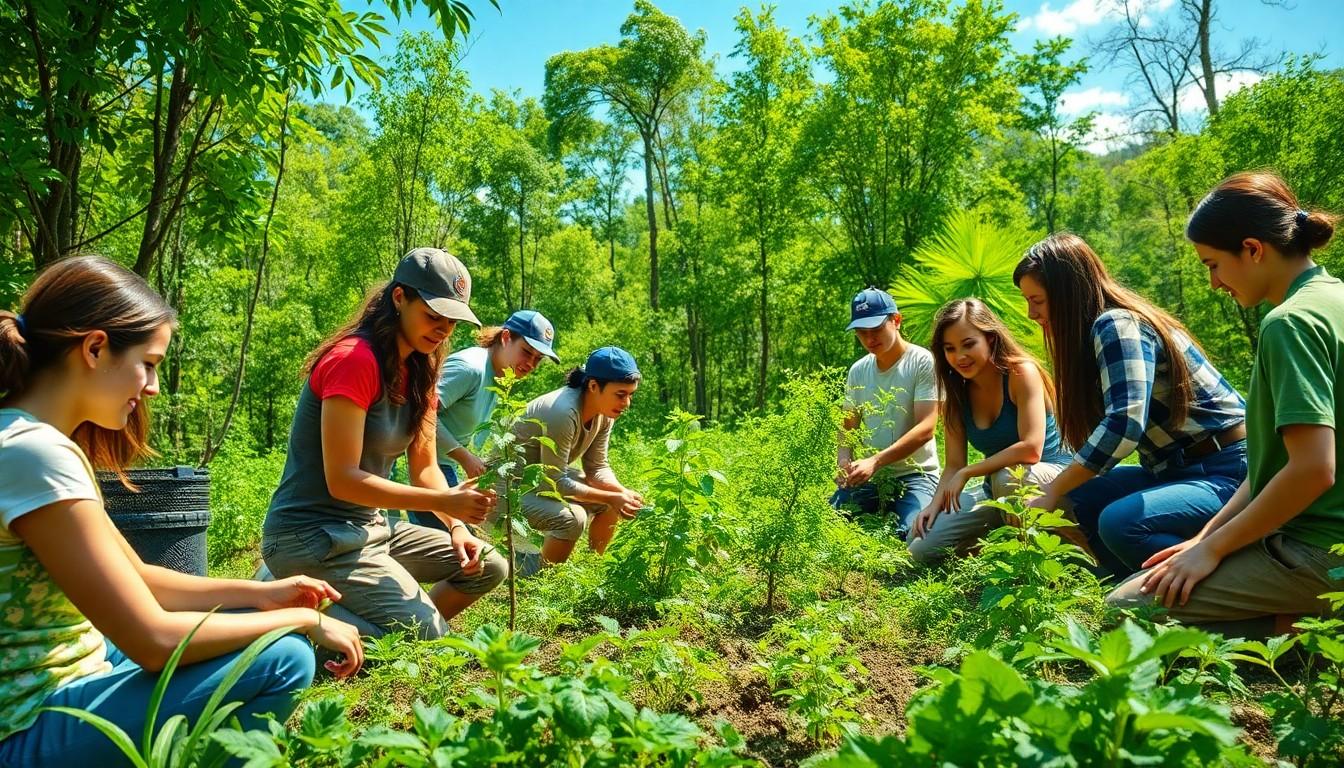In a world where plastic straws seem to have more power than a superhero, nature conservation charities are stepping in to save the day. These organizations work tirelessly to protect our planet’s precious ecosystems and wildlife, proving that even the smallest actions can lead to monumental change. Whether it’s rescuing endangered species or planting trees faster than you can say “save the bees,” they’re on a mission to keep our Earth thriving.
But let’s be real—saving the planet doesn’t have to be all doom and gloom. With a sprinkle of humor and a dash of creativity, these charities make conservation feel less like a chore and more like a community effort. Join the cause and discover how a little support can go a long way in helping Mother Nature get back on her feet. After all, who wouldn’t want to be part of the coolest team on the planet?
Nature Conservation Charity
Nature conservation charities play an essential role in safeguarding ecosystems and wildlife. These organizations implement various programs focused on restoration, protection, and education. Efforts include habitat preservation, species rehabilitation, and public awareness campaigns.
Many local and global initiatives demonstrate the impact of collective efforts. For example, organizations like the World Wildlife Fund (WWF) and The Nature Conservancy engage millions in conservation activities. Their outreach programs inspire community members to participate in local conservation efforts.
Grassroots movements also contribute to building awareness. Community gardens and clean-up events encourage residents to connect with nature. Educational workshops address the importance of biodiversity and sustainable practices.
Statistics reveal the urgency of conservation efforts. According to the International Union for Conservation of Nature (IUCN), over 1 million species face extinction. Such alarming figures highlight the necessity for proactive measures.
Partnerships between conservation charities and corporations further amplify their impact. Many businesses support sustainable practices by funding projects or offering resources. These collaborations not only enhance conservation initiatives, but foster a culture of environmental responsibility.
Volunteer opportunities abound, allowing individuals to contribute directly. Activities range from planting trees to monitoring wildlife populations. Engaging in these hands-on experiences creates a sense of ownership in protecting the planet.
Innovative approaches in storytelling increase engagement. Charities utilize social media and multimedia campaigns to share success stories. By showcasing tangible results of their work, they inspire donations and support.
Nature conservation charities embody a commitment to preserving the environment for future generations. Their combined efforts demonstrate that everyone can play a part in this critical mission.
Importance Of Nature Conservation
Nature conservation plays a crucial role in maintaining the planet’s health and supporting life. It ensures ecosystems remain balanced and resilient.
Benefits To Biodiversity
Biodiversity supports ecosystem functioning and resilience. Various species contribute to food webs and nutrient cycling. Communities rely on diverse flora and fauna for sustenance and cultural identity. Nature conservation charities enhance habitat preservation and species rehabilitation initiatives. For instance, protecting wetlands and forests promotes wildlife sustainability. The IUCN states that approximately 1 million species face extinction within decades, making conservation efforts vital. Communities engaged in conservation practices foster awareness and unity, ensuring collective action benefits local wildlife.
Impact On Climate Change
Nature conservation helps mitigate climate change effects. Protected areas absorb carbon dioxide, significantly reducing greenhouse gas levels. Forest conservation, for example, plays a substantial role in carbon sequestration. Engaging in restoration projects enhances ecosystem capacity to combat climate impacts. Numerous studies link biodiversity loss to increased climate vulnerability, stressing the urgency of conservation. Initiatives aimed at reforesting landscapes have proven effective, receiving support from organizations like WWF. Implementing sustainable agricultural practices can further decrease carbon footprints and promote resilience. Conservation charities empower individuals to take meaningful climate action in their communities.
How Nature Conservation Charities Operate
Nature conservation charities operate through a complex network of funding and project execution. They leverage various methods to achieve their environmental goals.
Funding Sources
Charities secure funds from multiple sources to support their initiatives. Donations from individuals, corporations, and foundations play a significant role in financing conservation projects. Grants from government agencies and international organizations supplement these funds. Membership fees also contribute, allowing supporters to engage actively with the charities. Fundraising events, such as auctions and sponsorship drives, provide another avenue to obtain financial resources. With a diverse funding model, these organizations ensure sustainability and independence.
Project Implementation
Project implementation involves strategic planning to tackle specific conservation challenges. Charities assess local ecosystems and identify key areas that require intervention. They engage with communities to foster participation and prioritize local needs. Collaboration with governments and stakeholders is essential in establishing conservation initiatives. Monitoring and evaluation of projects ensure their effectiveness and adaptability over time. Education and outreach programs raise awareness about the importance of biodiversity and ecosystem health. These organizations adapt their strategies based on real-time data and community feedback to maximize their impact.
Notable Nature Conservation Charities
The World Wildlife Fund (WWF) leads global efforts in wildlife preservation and habitat protection. Founded in 1961, it advocates for endangered species and promotes sustainable practices across various ecosystems. They engage millions through impactful campaigns that raise awareness and inspire action.
The Nature Conservancy focuses on land and water conservation. This organization collaborates with local communities to protect vital habitats. Their science-driven initiatives result in significant advancements in environmental sustainability. Additionally, they manage approximately 1 million acres worldwide, demonstrating their commitment to biodiversity.
Oceana aims to protect the world’s oceans. This organization advocates for sustainable fishing practices and marine habitat protection. They utilize scientific research to influence policy changes that benefit marine life and ecosystems. Engaging the public through petitions and outreach programs has led to positive legislative outcomes.
Greenpeace utilizes direct action and advocacy to address environmental issues. Founded in 1971, they campaign against deforestation, pollution, and climate change. Their efforts have successfully raised global awareness and promoted sustainable energy practices.
BirdLife International prioritizes bird conservation and the ecosystems they inhabit. Through global partnerships, they monitor critical habitats and advocate for policy changes to protect avian species. Their BirdLife Partnership consists of over 100 organizations working collaboratively to ensure the survival of threatened bird populations.
In addition, the Conservation Fund integrates land protection with community development. They focus on preserving natural areas while creating economic opportunities. Their multifaceted approach enhances conservation efforts and strengthens local economies.
Each of these organizations exemplifies the dedication to nature conservation. They collectively work towards preserving ecosystems and promoting awareness. Charitable support enhances their mission to protect the planet and its inhabitants.
Ways To Support Nature Conservation Charities
Supporting nature conservation charities involves various methods that anyone can adopt. Individuals can make direct contributions through financial donations. Regular monthly gifts enhance project sustainability and ensure that organizations can plan for their long-term initiatives.
Participating in volunteer opportunities provides hands-on experience. Volunteers assist with habitat restoration activities, wildlife surveys, or educational outreach programs. Engaging in local clean-ups not only contributes to immediate environmental benefits but also fosters a sense of community involvement.
Raising awareness through social media channels helps spread the word about conservation issues. Sharing stories and campaigns amplifies the voice of these organizations and encourages others to take action. Contributing to fundraising events, like charity runs or auctions, further supports their initiatives while creating engaging community experiences.
Choosing eco-friendly products from corporate partners of conservation charities generates funds for environmental projects. These partnerships often reflect a mutual commitment to sustainability, enhancing the impact of both businesses and charities.
Supporting nature conservation extends to advocating for policies that protect ecosystems. Individuals can influence legislation and promote sustainable practices in their communities. Writing letters to local representatives about conservation issues fosters accountability and informs decision-makers of public sentiment.
Lastly, educating oneself and others about biodiversity and conservation challenges creates a knowledgeable community. Understanding the urgency of the crisis, such as the IUCN’s warning that 1 million species face extinction, inspires collective action. Each effort contributes to developing a culture of conservation that prioritizes the health of the planet.
Embracing Sustainable Practices
Supporting nature conservation charities is essential for the health of our planet. Every action taken—whether it’s volunteering time or donating funds—can make a difference. By engaging with these organizations, individuals not only contribute to vital conservation efforts but also become part of a larger community dedicated to preserving ecosystems and wildlife.
The urgency of the current environmental crisis calls for immediate action. As awareness grows and more people join the cause, the collective impact can lead to significant change. Embracing sustainable practices and advocating for conservation sets a positive example for future generations. Together, they can foster a culture of stewardship that prioritizes the well-being of our planet and its diverse inhabitants.


